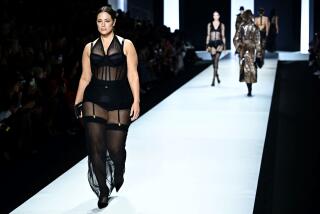New Sizes Promise to Make Dressing Less of a Hassle
- Share via
Women’s bodies change as they age. But sizes don’t. Dresses may fit through the waist but fall off the shoulders of older women. And they may find it more comfortable to wear elastic-waist pants backward, with the fullness in front.
Now, for the 17 million American women over 55, help may be on the way in the form of a new size category designed by Ellen Goldsberry and Naomi Reich of the University of Arizona Cooperative Extension Service. After taking 57 measurements--everything from the circumference of the waist to the slope of the shoulders--of almost 7,000 volunteers over 55, the pair began feeding their data into a computer. Goldsberry expects to have the sizing perfected within a year and a half. Then, manufacturers can use the new pattern sizes to cut clothes.
Initial findings indicate a desperate need for the new sizes. “We heard the same story over and over. It was one of horrendous frustrations. Often, salespeople would suggest these women needed to go to a bigger size. Big was not what they were looking for; they were looking for things that fit,” Goldsberry says.
As a woman ages, Goldsberry explains, she may lose as much as 3 or 4 inches in height. Her shoulders begin to roll forward, causing the rib cage to expand. The waistline thickens and the buttocks flatten.
These perfectly natural changes create a series of fitting problems. When the shoulders roll forward, the chest narrows and the back widens. The head is thrust forward for balance, causing necklines to gape in the front and pull across the back. As the tummy protrudes and the hips flatten, pants and skirts no longer fit properly: Waistlines pinch; front panels stretch too tight; fabric in the rear sags.
Sessions with the volunteers began with Goldsberry explaining the physiological effects of aging. “They all thought they were the only ones that were having these problems. They were relieved to hear they were not alone,” she says.
At Hollenbeck Home, a Los Angeles retirement community, several women well over 55 recently echoed the complaints of the Arizona volunteers.
“Pants aren’t long enough in the stride, and neither are pantyhose,” Nora Brooks said. “Plus the elastic in the waistbands is always too tight.”
The mention of pantyhose unleashed grievances about undergarments in general. “They don’t stretch as much as they used to,” one woman said. “You really have to struggle to get into them,” said a second. “And the elastic doesn’t last very long,” said another.
And going to a larger size may not be the answer, the women said, particularly when it comes to tops.
“They don’t make clothes to fit rounded shoulders. It’s especially a problem in jackets and dresses,” Olive Higgins said, explaining that the forward roll causes clothes to hike up in the back. A larger size may help the gap in back, but then it’s much too large in front, she said.
Big clothing companies have largely ignored the plight of older women, but that’s changing as the first of the baby boomers pass through middle age into that final demographic range. Lands’ End, Levi Strauss and McCall Patterns, to name a few, helped to finance the size study for the Institute for Standards and Research, which is under contract with the U.S. Department of Commerce to conduct the tests.
The sponsors say it’s too soon to speculate on the future of the new size category.
But Goldsberry says there is a way to ensure that the size comes to fruition: Customers should ask for it. Loudly. “Vocal consumers can change the market a great deal,” she says.
Clothes and the Aging Body After measuring almost 7,000 women older than 55, a pair of researchers are developing new sizes to accommodate the aging body. * Height
Older women may lose as many as 3 or 4 inches in height as the spinal column condenses between vertebrae. As a result, the rib cage, waist and hips eventually expand, the shoulders roll forward, the buttocks flatten and the tummy protrudes. Changes in muscle tone, body mass and bone structure also occur over time.
* Head and Neck
To accommodate the change in stance, the head is thrust forward, causing some necklines--such as the jewel and boat neck--to gap. V-necks tend to slide to the back. * Torso
The rib cage, waist and hips eventually expand.
* Waist and Hips
As the tummy protrudes and the buttocks flatten, some women find it more comfortable to wear elastic-waist pants backward, with the fullness in the front. A thickening waist also may mean a larger dress size--which may be too roomy in the shoulders. * Shoulders
When the shoulders begin to roll forward, the chest narrows and the back broadens. Clothes become loose across the chest, tight across the back. * Abdomen
The tummy protrudes.
* Overall Changes
Changes in muscle tone, body mass and bone structure also occur over time.
Sources: Ellen Goldsberry and Naomi Reich of University of Arizona Cooperative Extension Service.
More to Read
Sign up for Essential California
The most important California stories and recommendations in your inbox every morning.
You may occasionally receive promotional content from the Los Angeles Times.










